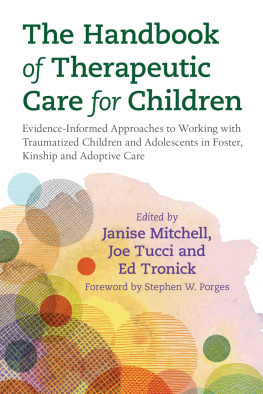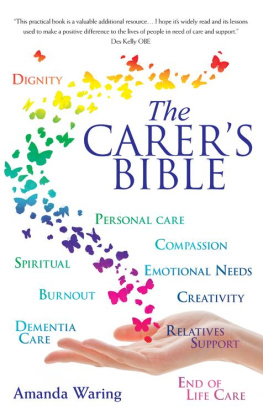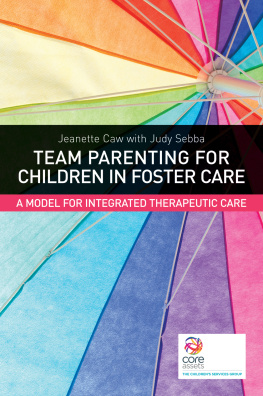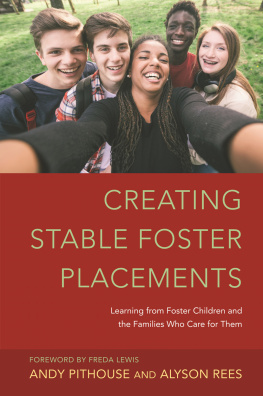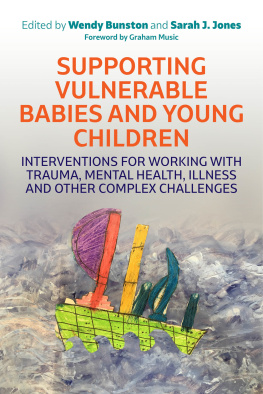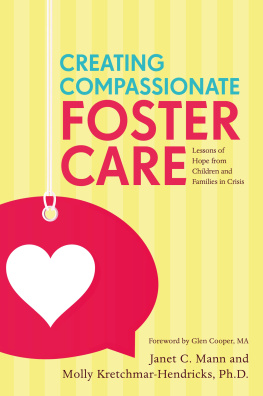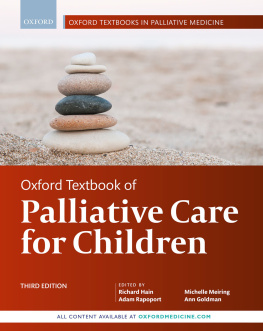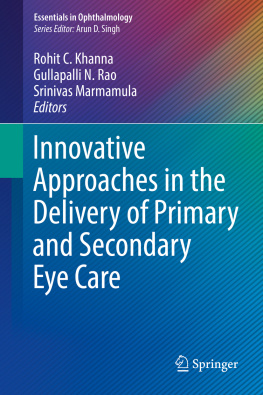
The Handbook of
THERAPEUTIC CARE
for CHILDREN
Evidence-Informed Approaches to Working
with Traumatized Children and Adolescents
in Foster, Kinship and Adoptive Care
Edited by JANISE MITCHELL, JOE TUCCI
and ED TRONICK
Foreword by Stephen W. Porges

Contents
Foreword
Feeling Safe is the Treatment
STEPHEN W. PORGES, PHD
Mitchell, Tucci, and Tronick have assembled a paradigm-shifting volume that informs us about the unique vulnerabilities of children exposed to trauma and abuse. The book is organized around an evolving treatment model developed by staff, affiliates, and collaborators of the Australian Childhood Foundation (ACF). During the past decade, ACF implemented a bold and innovative strategy to inform clinicians, scientists, and educators about the breakthrough treatment for trauma and cutting-edge research that conceptualized the neural pathways through which traumatic events are transformed into debilitating mental and physical health. This strategy focused on engaging world-renowned innovators in the field of traumatology.
Initially, ACF invited pioneering clinicians and scientists to inform their staff and to conduct workshops for clinicians and educators in Australia. This evolved into a biennial trauma summit in which world-leading researchers, clinicians, and advocates in traumatology met in Melbourne and shared their knowledge and insights with more than 2500 conference participants. As clinicians and educators were informed through these structured vehicles (i.e. workshops and summit), ACF incorporated this knowledge into a model of improved treatment for children with trauma histories, who were dependent on foster, kinship, and adoptive care. This Handbook is a product of the synergistic collaborations between ACF and the clinicians and scientists who have been welcomed into the ACF community.
By targeting the volume to children who, following trauma and abuse, have been placed in foster, kinship, and adoptive care, the four major points of the Handbook are unveiled. First, due to the greater physical and neural vulnerability of the young child relative to a full-grown adult, trauma and abuse result in a trajectory with frequently poorer outcomes. Second, trauma experiences have the potential to retune the childs nervous system from a normal state of welcoming and trust to a chronic state of defense devoid of the feelings of safety that the nervous system requires to thrive and develop. Third, treatment models for these vulnerable children need to reconceptualize the childs chronic defensiveness as a neurobiologically driven adaptive response that lowers thresholds to be aggressive and raises the threshold to detect and respond to cues of safety. Fourth, a unique model of care, therapeutic child care , is presented, which attempts to facilitate the positive development of children with trauma histories, who have been removed from their biological families and placed in foster, kinship, and adoptive care. These are the children who, by being locked in a chronic state of defense, are the least welcoming to well-intentioned approaches of support and the least receptive to cues of safety and trust.
As we study the impact of trauma and abuse, we learn through the absence of specific emotional reactions and social behaviors what it is to be a successful, adaptive, and social human. In the study of adult survivors, we see the loss of function in real time. Almost immediately after the traumatic insult, we can see the massive impact of the trauma on the individual. We see trauma retune a survivor from loving and trusting others into a withdrawn individual who distances from previous social relationships, finds it difficult to trust friends, and loses a sense of purpose and a desire to live. These changes occur rapidly as the body changes neural state in response to a violation of trust and an expectancy to be safe. This sequence provides a window to see the unfolding of phylogenetically newer neural circuits that evolved to enable connectedness and co-regulation with others. With this unfolding following trauma, reflecting a disinhibition of evolutionarily ancient defense mechanisms, we are informed that the critical and most devastating transformative biobehavioral feature is a loss of feeling safe and a capacity to connect and share moments of intimacy with others. This trajectory, illustrating the loss of affiliative function and trust, provides therapeutic clues of the importance of reintroducing cues of safety to down-regulate states of defense and to provide opportunities to engage and co-regulate.
In the case of child survivors of trauma and abuse, the opportunity to feel safe is frequently limited or non-existent during early child development. These children are often abruptly removed from the care of their biological parents and assigned by government agencies into foster, kinship, or adoptive care settings that, at least initially, do not provide a resource base of connectedness and co-regulation with family that would be consistent with biological (i.e. evolutionary) expectation. By being born into severely dysregulated families, these children never have had the opportunity to experience a prolonged period of safety consistent with their bodily needs for health, growth, and restoration. Without feeling safe, the childs nervous system becomes highly reactive to violations of contingent reciprocity and incapable of the self-regulation necessary for spontaneous repairs.
The impact of disruptions of normal childparent connectedness may be visualized through the Tronick still-face model (Tronick et al ., 1978). This brief laboratory manipulation requires the mother, after social engaging and interacting with the infant, to abruptly freeze her face in a blank expression for a couple of minutes. This disengagement serves as a violation of the expectancy for reciprocal interaction and co-regulation with the mother. Often this disruption results in the child crying or going into a tantrum. The disruption is short-lived, when the mother is required to repair the disruption by re-engaging and calming the infant. As a model of transitory disruptions and repairs, the still-face paradigm provides insight into the adaptive flexibility of the childs nervous system. It is a model of the normal ruptures and rapid repairs that occur in healthy family units. However, in homes of abuse, repairs are infrequent and infant bouts of crying and tantrums often trigger physical and emotional abuse.
Using the still-face paradigm as a model of normal ruptures and repairs, researchers have been able to track the potency of maternal cues (e.g. facial expressions, intonations of voice, and gestures) on the infants behavior and autonomic state. The still-face paradigm provides a model to observe the adaptive importance of the caregivers engagement in the regulation of the infants physiological state to optimize health, growth, and restoration. However, violations without repairs, which characterize the environments of the children removed from the care of their biological parents, functionally retune the childs nervous system into a state of chronic defensiveness. This is in contrast to more optimal developmental environments, which reframe transitory disruptors into opportunities for repairs. A predictable cycle of disruption followed by repairs functions as a neural exercise increasing the effectiveness and efficiency of the repairs. This sequence improves the childs resilience. These sequences enable self-regulation to emerge from predictable opportunities for co-regulation. As the social interaction between the caregiver and infant becomes a predictable mode for co-regulation, a trust emerges that enables transitory violations, which are followed by repairs, to become a neural platform for humor (e.g. peek-a-boo) and play.
Next page
